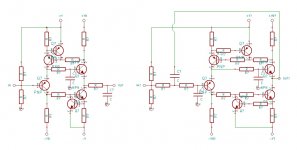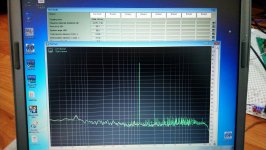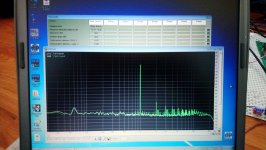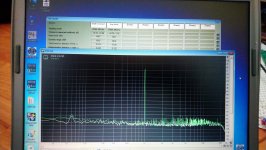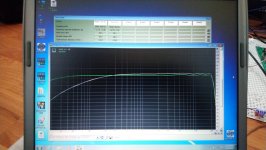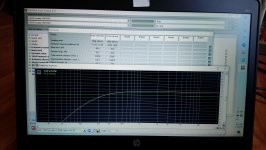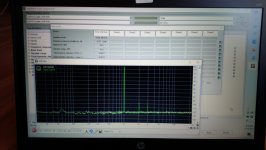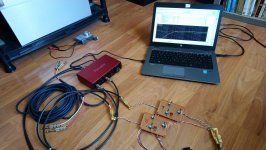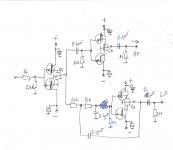There was a lot of discussion on this topic in the thread on the B1 active crossover.
Here's my summary: https://www.diyaudio.com/forums/pass-labs/156094-b1-active-crossover-10.html#post4990164
Here's my summary: https://www.diyaudio.com/forums/pass-labs/156094-b1-active-crossover-10.html#post4990164
read it 🙂
I wand as simple as possible because I want utmost transparency
I built lx mini modified crossover, and part of biamp 6-24 crossover, both not transparent enough
while they are being used in other systems, in the main system, they did not satisfy
both based on available J113, but I want to use original toshiba k170/j74
no need for bsc and shelving, that is taken care by ultracurve, plus biamping is taking care of different efficiencies in woofers vs mid/tweeters section
not reinventing, just scaling down to minimum
so far I was only happy with passive line level crossover, because in spite of dozen active I tried, none satisfied
I wand as simple as possible because I want utmost transparency
I built lx mini modified crossover, and part of biamp 6-24 crossover, both not transparent enough
while they are being used in other systems, in the main system, they did not satisfy
both based on available J113, but I want to use original toshiba k170/j74
no need for bsc and shelving, that is taken care by ultracurve, plus biamping is taking care of different efficiencies in woofers vs mid/tweeters section
not reinventing, just scaling down to minimum
so far I was only happy with passive line level crossover, because in spite of dozen active I tried, none satisfied
You can have a look at the Calvin buffer which has been discussed here or have a look at his webpage.
It might be a solution to simply try different ones if you haven´t found the one you like. With careful layout and a good regulated power supply these should prototype well on stripboard or similar.
Buffer - calvins-audio-pages
There is a menu to the left and both english and german descriptions.
Walt Jung´s diamond buffer : Op Amp Audio Buffers (2) - Walt Jung
It might be a solution to simply try different ones if you haven´t found the one you like. With careful layout and a good regulated power supply these should prototype well on stripboard or similar.
Buffer - calvins-audio-pages
There is a menu to the left and both english and german descriptions.
Walt Jung´s diamond buffer : Op Amp Audio Buffers (2) - Walt Jung
Last edited:
Interesting adason, I'm in the early stages of a somewhat similar OB project and will watch with interest. I'm planning a build based on the 'domestic' version of Nelson's SLOBs.
For my 'full range' units I'm thinking along the lines of combining the driver's natural rolloff and a bandwidth limited MoFo amp (rolling off at 150-180Hz by tweaking the input cap and inductor). I've built a single tweaked MoFo module but I need to build something with some gain to drive it properly as I don't have a source with sufficient output - once done I'll build a basic baffle and measure the drive unit response.
I'll need a LP crossover for the bass unit and one of the options I'm toying with is to experiment with this buffer:
JG buffer - I2S over USB Audio
I'm also fortunate to have half a dozen genuine vintage BUF-03 devices and wondering about putting a LP filter in front of this:
Aunt Corey's Homemade Buffered Passive Preamplifier Schematics | Stereophile.com
Nothing set in concrete yet, just exploring. If anyone has observations or suggestions it would be good to hear them.
For my 'full range' units I'm thinking along the lines of combining the driver's natural rolloff and a bandwidth limited MoFo amp (rolling off at 150-180Hz by tweaking the input cap and inductor). I've built a single tweaked MoFo module but I need to build something with some gain to drive it properly as I don't have a source with sufficient output - once done I'll build a basic baffle and measure the drive unit response.
I'll need a LP crossover for the bass unit and one of the options I'm toying with is to experiment with this buffer:
JG buffer - I2S over USB Audio
I'm also fortunate to have half a dozen genuine vintage BUF-03 devices and wondering about putting a LP filter in front of this:
Aunt Corey's Homemade Buffered Passive Preamplifier Schematics | Stereophile.com
Nothing set in concrete yet, just exploring. If anyone has observations or suggestions it would be good to hear them.
Just a thought, I wonder if the Sallen Key filter topology isn't the issue, rather than the J113 buffers?
I don't have a lot of justification for this, but I remember that the feedback increased higher order distortion.
Good luck.
I don't have a lot of justification for this, but I remember that the feedback increased higher order distortion.
Good luck.
What about BUF634 it is 10 times cheaper than the 40$ BUF03AJ
if you use MoFo to drive speakers, is is per se a buffer, you could use it as the buffer for the filter, connecting the cap that goes from the output to input resistors for LF and a resistor that goes to input caps for HF
if you use MoFo to drive speakers, is is per se a buffer, you could use it as the buffer for the filter, connecting the cap that goes from the output to input resistors for LF and a resistor that goes to input caps for HF
Last edited:
What about BUF634 it is 10 times cheaper than the 40$ BUF03AJ
But not as cheap as something I already have and, perhaps, not as good?
I'm also fortunate to have half a dozen genuine vintage BUF-03 devices...
if you use MoFo to drive speakers, is is per se a buffer, you could use it as the buffer for the filter, connecting the cap that goes from the output to input resistors for LF and a resistor that goes to input caps for HF
I'm only using a MoFo for the full-range unit and I think/hope I have the LF roll-off sorted for that by adjusting it's input cap and reducing the inductance of the mosfet load. For the bass driver I plan to use a chip amp and its the LP filter for it that I'm exploring.
Last edited:
I have grouped and selected jfets, in two categories, low idss, and high idss, for both n and p channel
matching n and p exactly is not that easy, but I allow for some tolerance, this is just for fun
so I have groups of six matching for idss ~4-5 mA, and another group with idss ~ 17-19 mA
I guess I will build two active crossovers, first the upper path, and see how it works and sounds
matching n and p exactly is not that easy, but I allow for some tolerance, this is just for fun
so I have groups of six matching for idss ~4-5 mA, and another group with idss ~ 17-19 mA
I guess I will build two active crossovers, first the upper path, and see how it works and sounds
finished low idss crossover, pretty happy with the result
distortion unmeasurable with my gear, so i ordered focusrite external sound card
when i do loop back, and through active crossover, its identical distortion, identical spectrum, except the rolloff in low fr
so far its as transparent as i want it
it starts rolling off little soon for me, i may add little more capacitance
distortion unmeasurable with my gear, so i ordered focusrite external sound card
when i do loop back, and through active crossover, its identical distortion, identical spectrum, except the rolloff in low fr
so far its as transparent as i want it
it starts rolling off little soon for me, i may add little more capacitance
Last edited:
I got lucky and obrained original unbuild borbely line stage kits.
Still ways to go, waiting for the sound card now.
Still ways to go, waiting for the sound card now.
before I post data from focusrite, let me just post previous with dell laptop, no soundcard
first is loop spectrum, second is simple active crossover spectrum, then comparison, not much difference, and fr response comparison as last
first is loop spectrum, second is simple active crossover spectrum, then comparison, not much difference, and fr response comparison as last
Attachments
here are some results with focusrite, I need to make some custom cables, I had to scavenge from behringer ultracurve, and for loop I only have very long cable
it took me a while to set all right, and still I need to learn all the settings
anyway, here is what I got
first is just set up, second pic is fr spectrum for the loop only, pretty clean, distortion ~0.0027%
next is simple active crossover, similar spectrum, distortion ~0.0034%
there you have it, I can measure the distortion now 🙂
last pic is fr response comparison
it took me a while to set all right, and still I need to learn all the settings
anyway, here is what I got
first is just set up, second pic is fr spectrum for the loop only, pretty clean, distortion ~0.0027%
next is simple active crossover, similar spectrum, distortion ~0.0034%
there you have it, I can measure the distortion now 🙂
last pic is fr response comparison
Attachments
Now that's what I call proper screenshots! I like it.
Good work and congrats you're happy now with that filter.
Good work and congrats you're happy now with that filter.
Would be good to do some tests with Arta, and reduce the level to at least -6db do some playing with loopback to find the sweet spot of the focusrite. Output and input levels need to be adjusted for optimum distortion and noise floor. I suspect your input level is too high based on noise floor being around -120db in the loopback. Should be able to get close to -140db I would think.
Tony.
Tony.
I do not have much update, except I finished the lower path section and tested it all together. Works great. When I plugged all in, I had two amplifiers after the crossover quite high in volume settings, and since I did not have volume before the active crossover, when I pressed 'play' on my cd player, it was louder than I expected. So I know now that is was unbelievably clean at level way above my normal listening volume. I am quite happy with the results. I will finish and box few of these for testing in big system.
Few observations: when I was experimenting, that 50 ohm trimmer may not be completely able to make total zero on the output, its range is limited, depending on the p and n channel jfet match. In some cased I had millivolt or so output at max position, so reluctantly I decided to add one more cap on the output. It does not hurt, and makes the slope little steeper for open baffle.
When I was experimenting with CRC upper path before the second buffer, I noted weird behavior sometimes, when I touched something, n channel jfet started to be fully open and I got 14.9 volts on the output. When I placed 1M ohm resistor from gates to ground, this never happened. So similarly, I placed the 1M on the low path too.
This is what I have now.
edit: one more thing, I used 2uF on the LF output, that's what I had, I will measure fr response later
Few observations: when I was experimenting, that 50 ohm trimmer may not be completely able to make total zero on the output, its range is limited, depending on the p and n channel jfet match. In some cased I had millivolt or so output at max position, so reluctantly I decided to add one more cap on the output. It does not hurt, and makes the slope little steeper for open baffle.
When I was experimenting with CRC upper path before the second buffer, I noted weird behavior sometimes, when I touched something, n channel jfet started to be fully open and I got 14.9 volts on the output. When I placed 1M ohm resistor from gates to ground, this never happened. So similarly, I placed the 1M on the low path too.
This is what I have now.
edit: one more thing, I used 2uF on the LF output, that's what I had, I will measure fr response later
Attachments
Last edited:
- Home
- Amplifiers
- Pass Labs
- simple active crossover
